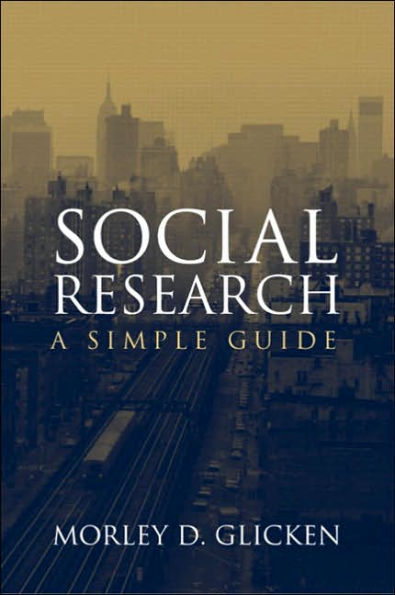Table of Contents
Each chapter begins with “Introduction,” and ends with “Summary,” “Review Questions,” “References,” and “Recommended Internet Sites.”
Preface.
Acknowledgement.
Dedication.
1. Why Bother Learning Research?
The Excitement of Discovery.
Knowledge: Is Some Knowledge Better Than Other Knowledge?
Inductive Versus Deductive Reasoning.
The Scientific Method.
Is the Scientific Method the Only Approach?
Creativity and Science.
The Three Ways of Doing Research.
Pure and Applied Research.
2. A Way of Viewing the Research Process: Research Paradigms.
The Four Paradigms.
Explanation, Usage, Examples of Each, Methodologies Used, Types of Data to Collect, Pros and Cons of Each Paradigm.
Which Paradigm Should You Choose for Your Research Project?
3. What's the Beef? A Look at Problem Formulations.
An Example of a Problem Formulation: Why Do So Few Men Enter the Helping Professions?
A Feminist Response to the Problem Formulation.
The Moral of the Story.
Choosing a Research Problem.
Walking You Through the Problem of Finding and Formulating a Suitable Problem to Study.
Have You Chosen the Correct Problem?
4. The Research Proposal.
The Purpose of the Proposal.
The Content of the Proposal.
Choosing a Topic.
Issues to Consider When Choosing a Topic.
A Suggested Outline for the Proposal.
Constructivist Proposals.
Critical Theory Studies.
Evaluation Protocol for Research Proposals.
5. The Literature Review.
Steps in Doing a Serious Literature Review.
Good and Bad Sources.
Commonly-Used Sources and Their Relative Quality.
How to Judge Well-Done Literature Reviews.
Plagiarism.
Locating Documents on the Internet.
Full-Text Data Bases in the Social Sciences.
Citations and Abstracts.
6. Using Instruments to Measure Behavior.
Creating Your Own Instrument.
Using an Instrument Created by Others.
Six Types of Validity.
Determining Reliability (Test-Retest, Split-Half Method).
Common Ways of Using Instruments.
Guidelines for Surveys.
7. Examples of Research Instruments.
Instrument 1: A Vague Likert Scale: The Dakota Measure of Spirituality (Scale and Discussion).
Instrument 2: A Behaviorally Oriented Likert Scale: The CES-D Measure of Depression: (Scale and Discussion).
Instrument 3: The Use of Vignettes: The Mt. Pleasant Crisis Scale (Scale and Discussion).
Instrument 4: An Open-Ended Instrument: Disclosure of AIDS in Latino Families (Scale and Discussion).
Making Sense Out of Open-Ended Answers.
The Importance of Cover Letters with Examples.
Sending Results Out to Respondents with an Actual Example.
8. Tough Research: Quantitative Designs.
The Characteristics of Quantitative Research (6 Characteristics Explained).
Comparison Between Experiment and Control Group.
Solomon Four-Group Designs.
Time Series Studies.
Quasi-Experimental Designs.
Survey Research.
Threats to Experimental Design.
9. Qualitative Designs.
Rules of Qualitative Research.
Types of Qualitative Studies.
Conclusions.
10: Sampling.
Sampling Bias and Sampling Error.
Sampling Terms: Statistic, Universe, Parameter, Population and Sampling Frame.
Probability Sampling.
Simple Random Sample.
Systematic Random Sample.
Stratified Random Sample.
Cluster Sampling.
Alterative Selection of Participants.
Non-Probability Sampling.
Error Rates in Sampling with Examples.
Margin of Error with Examples.
To Sample or Not? The Strengths and Weaknesses of Sampling in the Social Sciences with Examples.
11. Sadistic Statistics: Part 1: Central Tendency and Chance.
The Statistics Covered in This Book.
Types of Data: Nominal, Ordinal and Interval.
Central Tendency.
The Role of Chance in Research Findings.
The Chi-Squared Test to Determine Chance.
T-Tests.
12. Sadistic Statistics: Part 2 Correlations.
Understanding the Meaning of Correlation Scores.
The Concept of Variance with an Example.
Regression Analysis with an Example.
ANOVAS and Beyond.
Planed Versus Unplanned Comparisons.
Reporting Statistics in a Research Report with an Example.
Using Computerized Statistical Packages.
13. Ethics in Research.
The Human Subject Approval Process.
Types of Human Subjects Reviews.
The Information Requested by Human Subject Committees.
Approval Letters from Agencies and from Creators of Instruments You May Want to Use.
Risks and Benefits of the Study and Their Relative Impact on Human Subjects.
Informed Consent and Debriefing Statement.
Guidelines for Informed Consent.
Examples of Informed Consent.
Debriefing Statements.
Example of Debriefing Statement.
Ethical Lapses.
14. Writing the Research Report.
The Research Report Outline with Examples.
What to Include in a Research Report.
Assessing the Quality of a Research Report: A Way of Helping Students Self-Evaluate Their Work.
An Actual Research Report.
Hints for Better Writing.
Personal Observations on Report Writing.
15. Our Role as Social Researchers.
An Example of the Use of a Research Study for the Popular Media and the Impact It Had.Hhow to Read and Comprehend Research Findings.
Thanks to the Reader.
Glossary of Terms.
Index.






